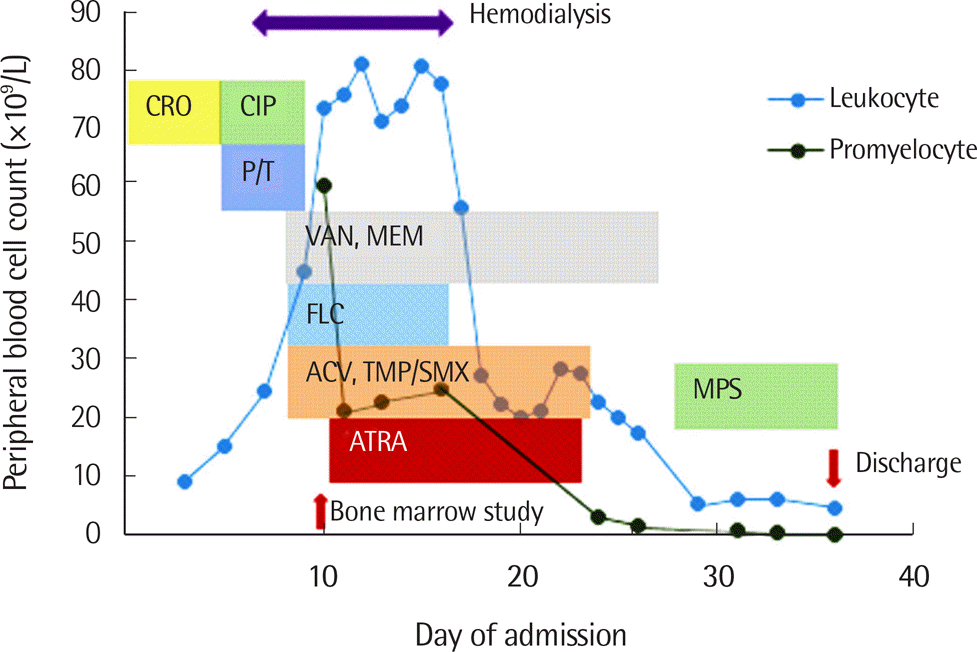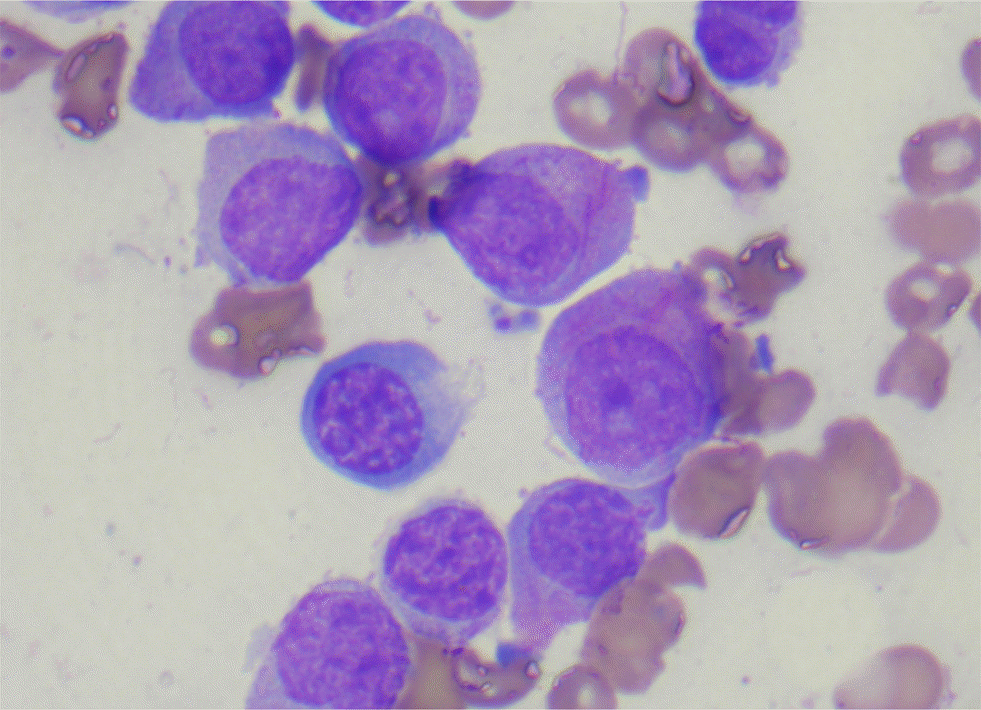Abstract
Neutrophilic leukemoid reaction may occur in many situations, including hemolysis, malignancy, infection, and exposure to certain toxins. It usually shows morphological overlap with chronic myeloid leukemia in which promyelocytes are not majorly associated. Here, we present a case of promyelocytic leukemoid reaction in a patient with sepsis. A 28-year-old man was admitted for renal stone removal. After percutaneous nephrolithotomy, his condition deteriorated with fever (37.8°C), tachycardia (130/min), acute renal failure, pleural effusion, and pulmonary edema. Complete blood count indicated a white blood cell count of 73.39×109/L including 82% promyelocytes, hemoglobin 8.9 g/dL, and platelet count of 85×109/L. A bone marrow aspirate showed that promyelocytes accounted for 73.8% of all nucleated cells. Following bone marrow examination, treatment with all-trans retinoic acid (ATRA) was started immediately. Reverse transcription polymerase chain reaction (RT-PCR) study revealed the absence of PML-RARA (promyelocytic leukemia-retinoic acid receptor alpha) and other RARA (retinoic acid receptor alpha) rearrangements. Once the chromosome analysis of bone marrow cells demonstrated the normal karyotype, ATRA was discontinued.
REFERENCES
1.George TI. Malignant or benign leukocytosis. Hematology Am Soc Hematol Educ Program. 2012. 2012:475–84.

2.Ahmed MA. Promyelocytic leukaemoid reaction: an atypical presentation of mycobacterial infection. Acta Haematol. 1991. 85:143–5.

3.Sanal SM., Campbell EW Jr., Bowdler AJ., Brat PJ. Pseudoleukemia: when “leukemia” is not leukemia. Postgrad Med. 1979. 65:143–5.
4.Singh ZN., Kotwal J., Choudhry VP., Bhargava M. Leukemoid reaction simulating acute promyelocytic leukemia. J Assoc Physicians India. 1999. 47:1031–2.
5.Grimwade D., Biondi A., Mozziconacci MJ., Hagemeijer A., Berger R., Neat M, et al. Characterization of acute promyelocytic leukemia cases lacking the classic t(15;17): results of the European Working Party. Groupe Français de Cytogénétique Hématologique, Groupe de Français d'He-matologie Cellulaire, UK Cancer Cytogenetics Group and BIOMED 1 European Community-Concerted Action “Molecular Cytogenetic Diagnosis in Haematological Malignancies”. Blood. 2000. 96:1297–308.
6.Welch JS., Westervelt P., Ding L., Larson DE., Klco JM., Kulkarni S, et al. Use of whole-genome sequencing to diagnose a cryptic fusion oncogene. JAMA. 2011. 305:1577–84.

7.Abedin S., Altman JK. Acute promyelocytic leukemia: preventing early complications and late toxicities. Hematology Am Soc Hematol Educ Program. 2016. 2016(1):10–5.

8.Applegate CC., Lane MA. Role of retinoids in the prevention and treatment of colorectal cancer. World J Gastrointest Oncol. 2015. 7:184–203.

9.Tavakolpour S., Daneshpazhooh M., Mahmoudi HR., Balighi K. The dual nature of retinoic acid in pemphigus and its therapeutic potential: Special focus on all-trans Retinoic Acid. Int Immunopharmacol. 2016. 36:180–6.

10.Miziołek B., Bergler-Czop B., Stańkowska A., Brzezińska-Wcisło L. The safety of isotretinoin in patients with lupus nephritis: a comprehensive review. Cutan Ocul Toxicol. 2017. 36:77–84.

11.Chen S., Yang Y., Xu J., Su L., Wang W. Effect of all-trans-retinoic acid on enterovirus 71 infection in vitro. Br J Nutr. 2014. 111:1586–93.
12.Coleman MM., Basdeo SA., Coleman AM., Cheallaigh CN., Peral de Castro C., McLaughlin AM, et al. All-trans retinoic acid augments autophagy during intracellular bacterial infection. Am J Respir Cell Mol Biol. 2018. 59:548–56.
Fig. 2.
Medication and patient progress. Abbreviations: CRO, ceftriaxone; CIP, ciprofloxacin; P/T, piperacillin/ tazobactam; VAN, vancomycin; MEM, meropenem; FLC, fluconazole; ACV, acyclovir; TMP/SMX, trimethoprim/sulfamethoxazole; MPS, methylprednisolone; ATRA, all-trans retinoic acid.

Table 1.
Reported cases of promyelocytic leukemoid reaction in the literature




 PDF
PDF ePub
ePub Citation
Citation Print
Print



 XML Download
XML Download